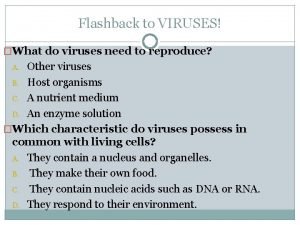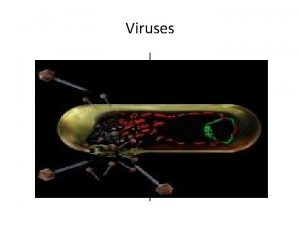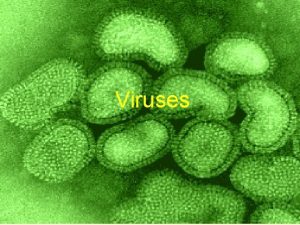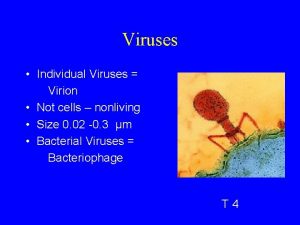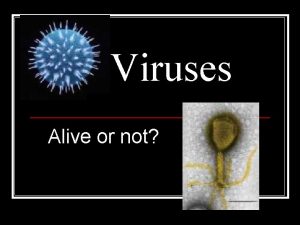VIRUSES Viruses Are Not Cells There are several











- Slides: 11

VIRUSES

Viruses Are Not Cells! There are several structural and functional differences between cells and viruses n The structural differences include: n – – – n No nucleus No cell membrane No organelles The functional differences include: – – Do not grow Do not respire Do not develop Do not reproduce

Viral Structure n Viruses are made up of 2 parts: – Capsid—a protein coat which enables the virus to bind to a cell – Nucleic acid—either DNA or RNA n Some viruses have an additional protective coating called an envelope

Replication vs. Reproduction n Viruses do not reproduce n Viruses replicate n Reproduction requires cell division and replication does not n A virus requires a host for it to replicate n A host is a living cell that provides all the materials a virus needs to replicate

Classification of Viruses n Shape: allows viruses to attach to only a few kinds of cells; like two pieces of a jigsaw puzzle – Filovirus—has no distinct shape § Ebola- Zaire Ebola Virus, has the highest case-fatality rate, up to 90%. Massive blood loss leads to death. – Polyhedral virus—multifaceted geometric shape § Herpesvirus- Cold sores, shingles, virus lays dormant along nerve fibers

− Binal virus—has a polyhedral capsid and a helical tail • Bacteriophage T 4 - virus which infects E. Coli. for molecular biology research − Helical virus—tightly coiled DNA or RNA inside a long, narrow capsid • Tobacco Mosaic Virus-infect members of nine plant families, 125 individual species

Classification of Viruses (cont. ) n Host: – Plant virus – Animal virus – Bacterial virus—these are also called bacteriophages

Lytic Cycle Bacteriophage Bacterial chromosome DNA or RNA Entry Bacterial host cell Attachment Lysis and Release Replication Assembly

Lysogenic Cycle Entry: Lysis & Release: Assembly: Not pictured Prophage Replication:

Retrovirus n Contains an RNA core that is replicated by 1 st transcribing its RNA into DNA n Ex: HIV—the virus that infects white blood cells and causes AIDS 1. RNA & reverse transcriptase enter the host cell 4. Viral DNA produces new viruses 2. Enzymes copy the viral RNA into DNA 3. Viral DNA attaches to cell DNA

Nonviral Particles n Viroid: – No capsid – Contains RNA – Cause plant diseases n Prion: – Protein molecule with no RNA or DNA – Cause animal diseases (i. e. mad cow disease)
 Lytic cycle animation
Lytic cycle animation Unlike lytic viruses, lysogenic viruses do not
Unlike lytic viruses, lysogenic viruses do not Mikael ferm
Mikael ferm Lysogenic viruses do not
Lysogenic viruses do not There are several ways
There are several ways Submentovertical projection
Submentovertical projection Alpha intercalated cell
Alpha intercalated cell Thyroid parafollicular cells
Thyroid parafollicular cells Somatic vs gamete
Somatic vs gamete Why dna is more stable than rna?
Why dna is more stable than rna? Red blood cells and white blood cells difference
Red blood cells and white blood cells difference Eukaryotic cells vs prokaryotic cells
Eukaryotic cells vs prokaryotic cells



